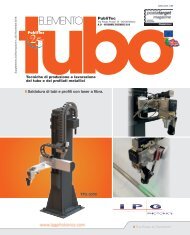AsseMec120_MAGGIU_2017
Create successful ePaper yourself
Turn your PDF publications into a flip-book with our unique Google optimized e-Paper software.
MERCATI ESTERI<br />
Il secondo produttore in Europa<br />
nel settore automotive<br />
Per quanto riguarda le importazioni, i settori più importanti<br />
per la Spagna sono l’energia (circa 20%), i prodotti chimici<br />
(16%), il settore automobilistico (13%) e i beni di consumo<br />
(12%). La Germania è il primo partner commerciale<br />
della Spagna, con una quota del 13%. Seguono la Francia<br />
(10,8%), la Cina (8,6%) e l’Italia (6,3%). L’Italia è quindi<br />
tra i principali partner commerciali del paese iberico, soprattutto<br />
nella vendita di prodotti chimici, componenti e<br />
accessori per l’industria automobilistica e prodotti siderurgici.<br />
I principali investimenti italiani nel paese interessano<br />
la fabbricazione di materiale e macchinari elettrici (37%),<br />
il commercio all’ingrosso (15%) e le costruzioni edili (7%).<br />
Il settore automotive è spesso utilizzato quale chiave di lettura<br />
del grado di automazione di una nazione. La Spagna<br />
è il secondo produttore in Europa e l’ottavo al mondo.<br />
Vanta il primato europeo nell’ambito dei veicoli industriali<br />
con la presenza di 9 multinazionali e 17 impianti di produzione.<br />
Circa l’83% dei veicoli prodotti in Spagna vengono<br />
venduti all’estero, in un centinaio nazioni e - dato ancora<br />
più interessante - la Spagna è sede di circa 1000 aziende<br />
di piccole e medie dimensioni che costituiscono il settore<br />
dei fornitori per l’industria automotive.<br />
Questo settore rappresenta circa il 10% del PIL e il 20% delle<br />
esportazioni nazionali, dando lavoro a 300.000 persone.<br />
Nel 2014 la produzione industriale spagnola nel settore è<br />
cresciuta dell’11%, raggiungendo i 2,4 milioni di autovetture<br />
prodotte, poi salite a 2,6 milioni nel 2015. Per il <strong>2017</strong> si<br />
pensa che la produzione industriale possa raggiungere i 3<br />
rather than by the business volume generated by the<br />
Italian companies in a specific sector, combined with<br />
the growth forecasts in percent in the given nation.<br />
It is interesting to understand the euro value that a<br />
given country is able to provide to Italian companies<br />
over the next three years. This concept (“Dollar vs<br />
Percentage Growth”) will guide future analysis even<br />
in identifying the “new markets”. The next articles will<br />
highlight how new markets, in this view, are in fact in<br />
Europe.<br />
When analyzing the monetary value and growth as<br />
a percentage of the Italian mechanics in the various<br />
European countries, it is extremely interesting to notice<br />
that nations with the largest volume of turnover often<br />
develop the highest growth rates in the purchase of<br />
Italian mechanics.<br />
It is therefore not correct to think that high growth<br />
opportunities are associated to low export volumes of<br />
Italian mechanical goods.<br />
The figures show exactly the opposite: wherever the<br />
Italian mechanical goods are already in the country<br />
and Italian companies have been able to show their<br />
skills both from a technological and commercial point<br />
of view, then there are interesting opportunities for<br />
future growth. To validate our opinion we will therefore<br />
consider economies such as France, Germany and the<br />
United States in the next issues.<br />
A dynamic economy after the crisis<br />
Spain is a constitutional monarchy with a population<br />
of about 46.4 million inhabitants, a per capita GDP of<br />
about €22,279 and a gross domestic product of just<br />
over one billion euro. With a very low inflation rate and<br />
a debt to GDP ratio of about 100%, this economy has<br />
similar figures compared to Italy. During the financial<br />
crisis, the unemployment rate exceeded the levels<br />
of Italy and yet today Spain is growing by around<br />
3%. It is indeed one of the most dynamic post-crisis<br />
economies, with an unemployment rate of about 11%.<br />
It is good to remind that the Iberian peninsula,<br />
regardless of its GDP that makes it the 14th world<br />
economy, has always been a bridge to North<br />
Africa and especially a preferred partner for the<br />
development of business relations in Central and South<br />
America.<br />
Most of the Spanish work force is in services (76%),<br />
industry (14%), construction (6%) and agriculture (4%).<br />
According to the National Statistics Institute, in 2015<br />
the lower growth rate was in agriculture (0.5%) and<br />
services (2.9%), while the most significant data come<br />
precisely from the industry, grown by 3.6% and the<br />
construction sector, grown by 5.8%. Industry is one of<br />
the main growth driver of the Spanish economy, the<br />
target sector for the Italian mechanical goods.<br />
The second European manufacturer<br />
in the automotive sector<br />
As regards to imports, the most important sectors for<br />
Spain are energy, which accounts for approximately<br />
20%, chemicals (16%), automotive (13%) and<br />
consumer goods (12%). Spain’s top trading partners<br />
are Germany (13%), France (10.8%), China (8.6%)<br />
and Italy (6.3%). Italy ranks therefore among the<br />
main trading partners in the country especially as for<br />
chemical products, components and accessories<br />
for the automotive industry and steel products. The<br />
main Italian investments in the country deal with<br />
the manufacturing of electrical machinery for 37%,<br />
wholesale for 15% and constructions for 7%.<br />
The automotive sector is often used as a key to<br />
understanding a nation’s degree of automation. Spain<br />
is the second largest manufacturer in Europe and the<br />
104 MAGGIO-GIUGNO <strong>2017</strong> & meccatronica 120





